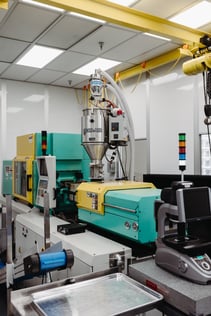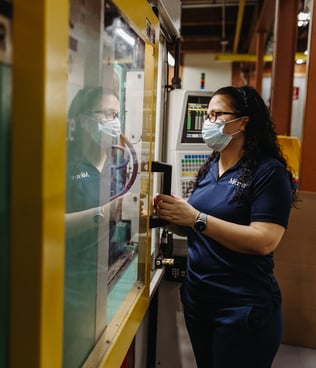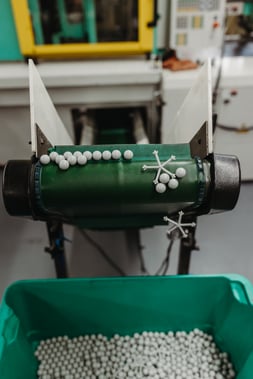In the evolving landscape of manufacturing and technology, Micron Solutions stands out as a leading company dedicated to innovation and quality. With a distinctive approach of maintaining a 10:1 ratio of people to machines, we have carved a niche for ourselves in the competitive world of manufacturing. This balance between automation and human resources shows how committed we are to achieving the best results possible.
Too Long; Didn’t Read
- Micron invests heavily in automation to help reduce human error, increase efficiency, and decrease costs.
- While automation helps in many ways, there are many facets to manufacturing that cannot be fully replaced by machines and technology.
- Automation can’t do it all, which is why we rely on our impressive workforce. Each day, our team brings creative insights and exceptional testing and quality control to ensure the highest quality output.
- We use a 10:1 people-to-machine ratio to optimize the mix between humans and technology.
Embracing Technological Advancements
To lead in the manufacturing industry, we must always be at the forefront of innovation. That's why we invest heavily in cutting-edge automation technologies. These investments aren't just about keeping up with the times; they are fundamental to our success.
Our automation strategy seeks to reduce repetitive and labor-intensive tasks. By optimizing workflows and reducing cycle times, we achieve higher throughput, greater agility, reduced human error, cost savings, and, most importantly, we consistently deliver the highest quality products to our customers.
Our Skilled Workforce
While machines help expedite processes and reduce turnaround time, we deeply value the expertise and skill of our workforce. We understand that our employees are the backbone of our success. That's why we invest significantly in our training, equipping them with the knowledge and skills required to adapt to ever-evolving roles and technologies.
Creative thinking and problem solving are areas where automation can have its limitations. Our employees play an indispensable role in inspecting, testing, and upholding the highest quality standards. We also take pride in contributing to keeping manufacturing jobs right here in the United States.
Working Together
Our strategy of maintaining a 10:1 people to machine ratio is a purposeful decision driven by our commitment to harness the best of both worlds: automation and human expertise. Internally, we call this “man-o-mation”.
Through cross-training initiatives, we encourage employees to work closely with machines, fostering an adaptable work environment. Furthermore, our emphasis on continuous improvement ensures that both humans and machines contribute invaluable insights, driving excellence and innovation throughout our operations.
man-o-mation Benefits and Outcomes
Increased Efficiency and Productivity
Our “man-o-mation” strategy not only streamlines production, but also reduces operational costs, enabling us to stay competitive in a fast-paced industry. Furthermore, we reduced lead times for our products to ensure quicker deliveries and enhanced customer satisfaction.
Enhanced Quality
Our commitment to quality shines through in the seamless integration of automation and human expertise, resulting in consistently high-quality products. By meticulously blending the precision of automated systems with the discerning eye of human inspectors, we ensure that every product meets stringent quality standards. This dedication to quality assurance remains at the core of our operations.
Adaptability to Market Changes
Our agile manufacturing processes empower us to quickly respond to shifting market demands, a valuable asset in today's fast-paced business environment. This adaptability not only helps us maintain a competitive edge but also ensures that we consistently deliver products that align with market dynamics, cementing our reputation as an industry leader capable of meeting the ever-evolving needs of our clients.
Challenges and Future Outlook
Upfront Automation Costs
While automation offers numerous advantages, we have to acknowledge the challenges and limitations that come with its implementation. Among these hurdles are the significant initial investment costs associated with acquiring and setting up automation systems. These complexities often require skilled personnel for installation, programming, and maintenance, adding another layer of cost and skill requirement.
Evolving Workforce Dynamics
With the increasing integration of automation and artificial intelligence, the roles of human workers are undergoing a transformation. This shift requires reevaluation of traditional job descriptions and demands workforce development and retraining initiatives.
As machines take over repetitive tasks, human workers must adapt to more complex, creative, and supervisory roles. Balancing the benefits of automation with the need for an agile, adaptable workforce is one of the key challenges in the contemporary manufacturing landscape.
Conclusion
We have redefined the manufacturing landscape with our innovative approach of maintaining a 10:1 ratio of people to machines. By effectively harnessing the power of automation while cherishing the indispensable contributions of our skilled workforce, we have achieved exceptional results in terms of efficiency, quality, and adaptability.


